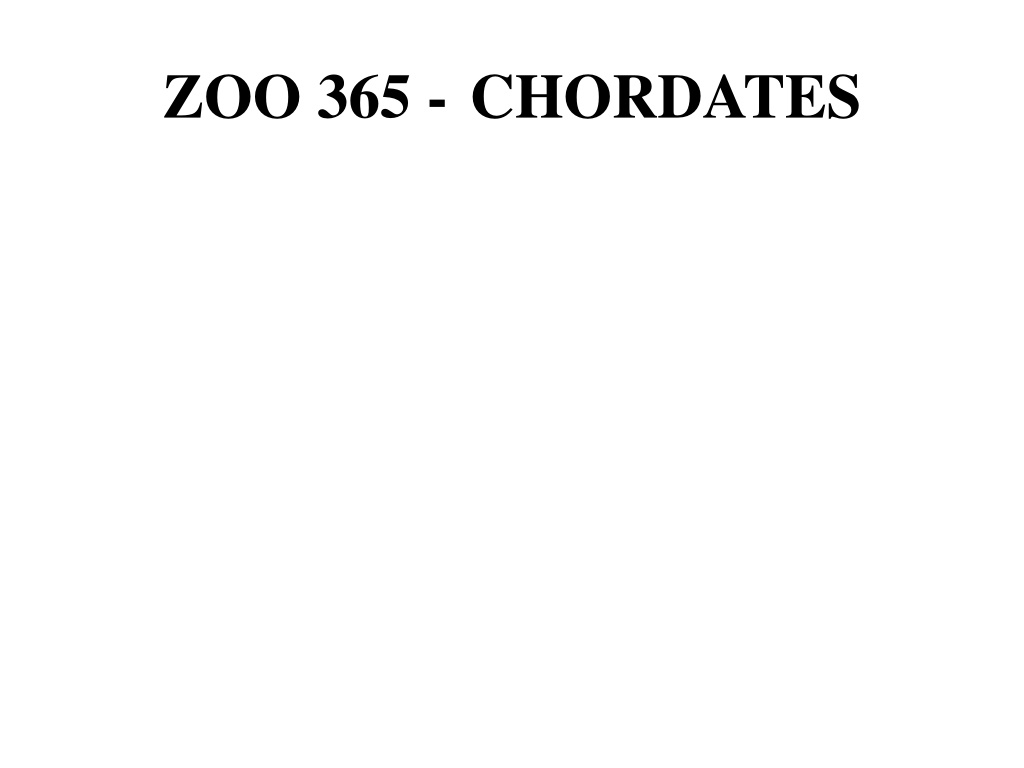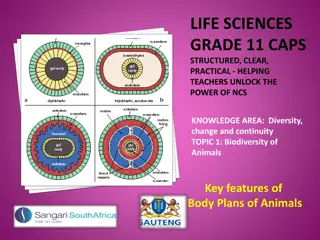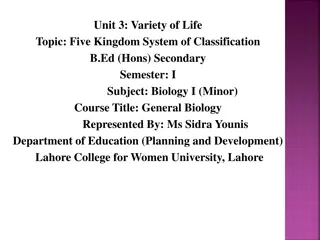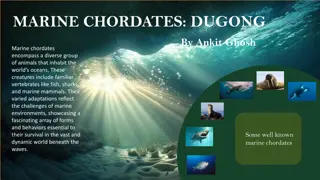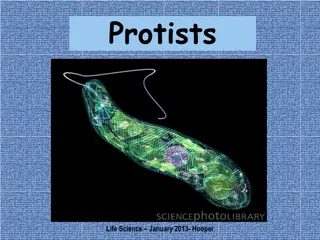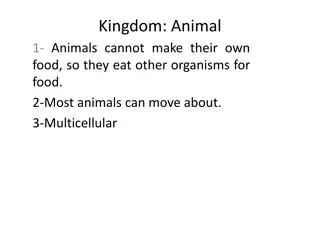Exploring the Diversity of Chordates in the Animal Kingdom
Delve into the world of chordates through vivid images and detailed descriptions, uncovering the classification of these fascinating creatures into subphyla and the distinctive features that define them. From acorn worms to mammals, each subgroup offers a unique glimpse into the rich tapestry of vertebrate life forms. Discover the evolution of nervous activity in chordates and the intriguing distinctions between Acrania and Craniata, shedding light on the complexity of biological diversity within this phylum.
Download Presentation

Please find below an Image/Link to download the presentation.
The content on the website is provided AS IS for your information and personal use only. It may not be sold, licensed, or shared on other websites without obtaining consent from the author. Download presentation by click this link. If you encounter any issues during the download, it is possible that the publisher has removed the file from their server.
E N D
Presentation Transcript
kingdom. Beside occupying various habitats, they have also reached the climax of nervours activity, as illustrated in class Mammalia to which man belongs.
The Chordata are classified into four subphyla:
1. Hemichodata, including acorn- worms,
2. Urochordata, including sea- squirts,
3. Cephalochordata, including Amphioxus, and
4 lampreys,fishes, amphibians, reptiles, birds and mammals. Craniata or Vertebrata, including
them, the Cephalochordata are also called the Acrania in contradistinction to the Craniata, being without or with a cranium repectively. The Acrania and Craniata are sometimes grouped together and referred to as the Euchordadta.
common basic plan of organization. Originally this plan is essentially that of a coelomate, marine, long-bodied, free-swimming creature which displays the following three main futures:
- The presence of a notochord, an axial rod of the skeleton, which extends in the dorsal region of the body.
The central nervous system is tubular, that is, containing a cavity, and lies dorsal to the notochord. -
- canal- the pharynx- is perforated by a variable number of gill-slits which lead into the gills. the anterior part of the alimentary
the adult urochordates, or may be transformed by the addition of skeletogenous tissues into a jointed hackbone or vertebral colum, as is characteristic of the Vertebrata. The gills never function at any stage of development of the Amniota (reptiles, birds and mammals) nor in the adult of most Amphibia.
features of the basic plan of chordate organization in a clear diagrammatic form. The characteristics of this basic plan, refereed to above, can well be seen in either a whole mount of this animal or in a T.S. of its pharyngeal region..
in length. It has the habit of burying itself in the sand during the day, with only its anterior part protruding, but swimming actively during the night.
Examine the provide specimen of Amphioxus, fresh or preserved, with the help of a hand-lens and note. The general body form is elongated, pointed at both ends and flattened at each side. The anterior end projects forwards as the rostrum. The fins are generally low and continous with each other: a dorsal, a ventral and a caudal fin. In addition, there are two lateral fins or metapleural folds. The mouth lies ventral to the rostrum and is guarded by the oral hood, the anterior edge of which carries long processes, the oral cirri. The atriopore is median and ventral, lies at the junction of two metrapleural folds and the ventral fin, at about one third of the way along the animal from its posterior end. It is the opening of the atrium. The anus lies on the left side, a short distance in front of the posterior end. The myotomes are arranged on both sides of the body as metamerical blocks of striated muscle fibres, separated by V-shaped partitions of connective tissue, the myosepta or myocommata. Note that the apices of the myosepta are pointing forwards. The gonads comprise about 26 pairs, metamerically arranged on both sides of the pharunx. The two sexes are sepatate, but are not externally distinguishable.
Examine under the microscope a whole mount of Amphioxus, preferably of a young specimen, and note in addition to the above-mentioned points: transverse partition called the velum which is perforated; its opening is sometimes called the enterosome . The velum carries a number of velar tentacles, and just infront of it there lies a peculiar wheel organ which helps in driving a current of water loaded with food particles into the mouth. Thus., Amphhioxus is a cliliary feeder. The closure of the mouth is effected by the folding over of the sides of the oral hood. The oral cirri help during feeding by turning inwards to prevent sand particles from passing into the buccal cavity. The notochord is an axial skeletal rod, which extends from the anterior to the posterior end of the body, near to its dorsal side. The nerve cord or spinal cord lies just above the notochord and similarly extends from end to end. Pigment may be visible along the cord, which represents eye spots. The cavity of the cord, or the central canal, may be seen in the preparation. The pharynx is voluminous region of the alimentary canal which extends from the velum to the beginning of the intestine. Its walls appear like a network on account of the presence in them of gill- bars, of two types: primary and secondary. The former are forked and reach the ventral wall of the pharunx, while the latter are not forked and do not reach that wall. The bars separate the fill-slits, and are all obliquely directed. Cross-bar or synapticulae connect the adjacent primary bars together. the buccal cavity or vestibule is guarded by the oral hood, at the hinder wall of which lies a vertical
pharynx, an epipharyngeal groove in the roof, and two peripharyngeal bands in front linking the endostyle with the epipharyngeal groove. All of these carry dilia which help in the process of feeding.
and gives off a forward blind extension, called the midgut diverticulum, on the right-hand side of the pharynx. The intestine opens posteriorly by the anus.
The atrium is a cavity which surrounds the pharynx and the anterior part of the intestine. It opens to the exterior by the atriopore. -
Examine and note: The dorsal and lateral fins, with fin rays in the former and lymph spaces in the latter. The skin is formed of the epidermis, which is composed of a simple columnar epithelium with goblet cells and covered by a thin cuticle, and of the dermis which is very thin. The myotomes and myosepta The notochoard, with vacuolated cells. The spinal cord, with the central canal. The pharynx, with primary and secondary gill-bars; the former alone contain portions of the coelom. The atrium,around the pharynx. The coelom appears as two dorsal canals, one on either side of the epipharyngeal groove. Parts of the coelom are also present in the primary gill-bars, below the endostyle, in the metapleural folds, and around the midgut diverticulum and the gonads. The gonads, one pair in the section, lie in the atrium on both sides of the pharynx. The midgut diverticulum, on the right side of the pharynx. Two lateral dorsal aortae, on the sides of the epipharyngeal groove.
Examine and note: Dorsal and lateral fins, skin, myotomes, myosepta, notochord and spinal cord as in preceding section. The extension from the atrium. The coelom surrounds the intestine. Identify the splanchnopleure and the somatopleaure. A single dorsal aorta is seen ventral to the notochoard, and between three and four subintestinal veins appear on the ventral surface of the intestine.
Examine and note: The dorsal and ventral lobes of caudal fine. The skin, myotomes, myosepta, notochord and spinal cord as in the two preceding sections. The caudal artery and caudal vein appear below the notochord the artery is dorsal to the vein.
How does Amphioxus feed and respire?
